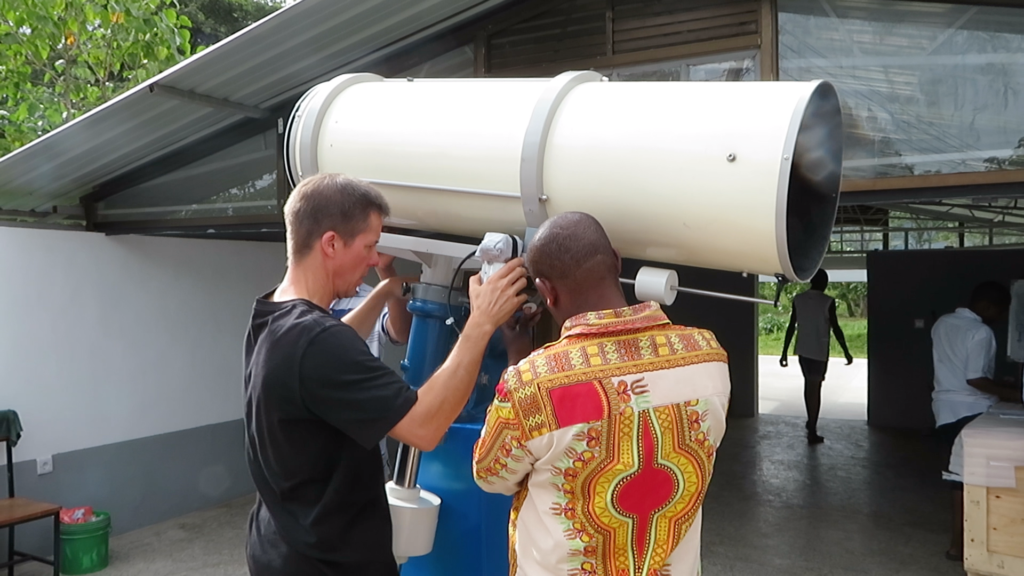
In this short video, Kai, Zacharia, and Eliona with the students of Ailanga school work to balance the 12″ Cave-Cassegrain telescope on both the declination and right ascension axes before mounting the motors.
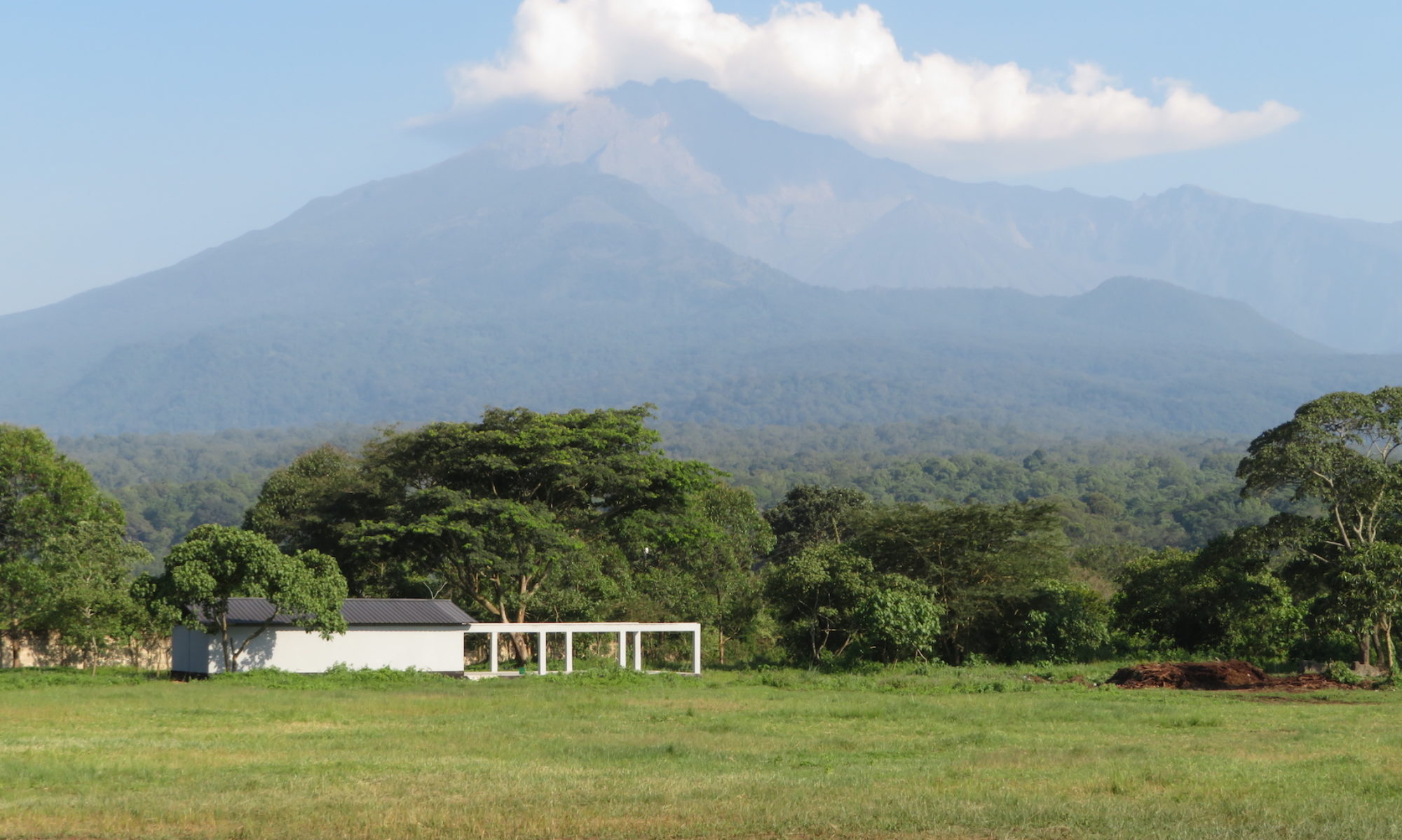
Mt. Meru Astronomical Observatory
Science Motivation for the Next Generation | Motivation ya Sayansi kwa Kizazi kijacho

In this short video, Kai, Zacharia, and Eliona with the students of Ailanga school work to balance the 12″ Cave-Cassegrain telescope on both the declination and right ascension axes before mounting the motors.
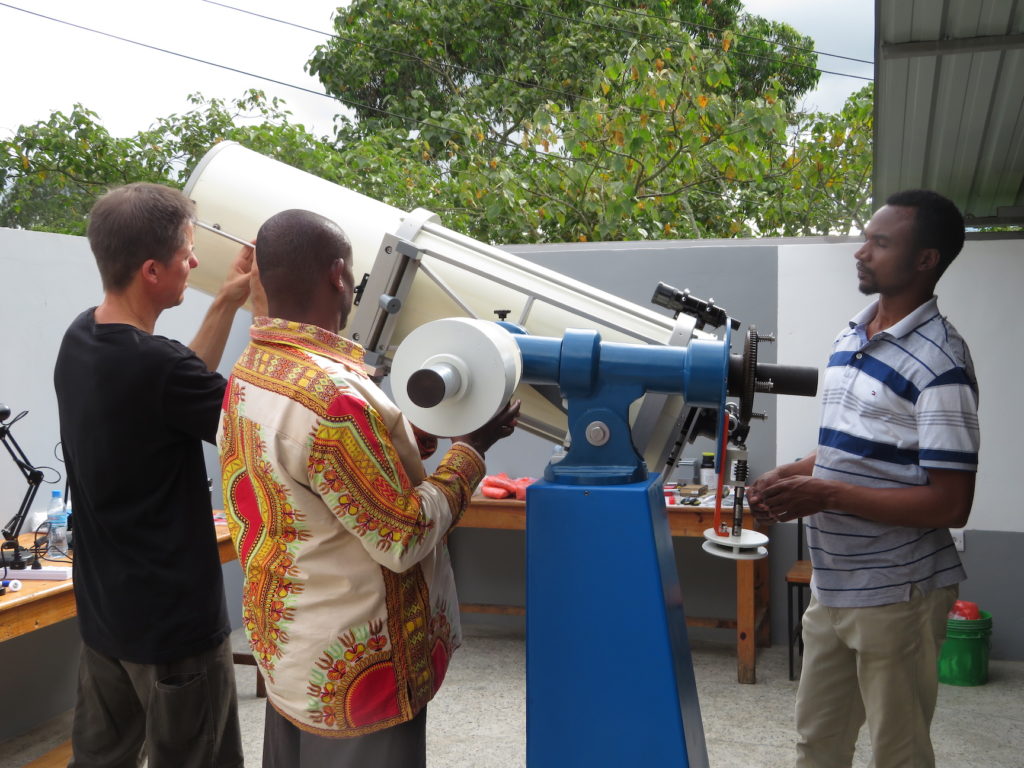
Today Eliona and Kai spent from 10 am until after 3 pm with a delegation from the US (Ailanga School Project), learning about their programs and history with the school, and sharing our own experience in the development of the observatory.
From 4-6 we worked with Zacharia and a number of students to balance the telescope before applying the motors. We were confused as to the behavior of the telescope at various angles, but with some diagrams on the white board we recognized that the center of gravity is not symmetrical due to the various, off-center components such as the motor mount block, motor, and spotting scope.
We added the small sandbag to one side of the tube to counter the motor and that helped tremendously. The Dec axis is very nearly perfectly balanced. The RA axis yet suffers from an awkward asymmetry, but we believe it may be due to a flat spot in the bearing or bearing housing itself, due to the tendency to return to the same position after certain rotations, and an audible/physical “click” in the same spot.
As there is nothing we can do to counter this, and it is quite subtle, we moved to mount the motors. The RA motor went on easily, and worked out of the box. The Dec motor was a bit tricky to install, as Kai recalled from his work on this area with Dan. What had not been previously recognized is that the threaded Dec shaft is very subtly bent. This causes an increase in friction at certain points, and the slipping of the stepping motor internal to its housing.
We experimented with a loose connection between the Dec shaft and the slip collar around the RA axis, and that allowed the motor to drive Dec flawlessly. So, the Teflon bushing will likely be replaced with a thin layer of foam instead.
Tomorrow should see the completion of the telescope, and if the clouds clear, first light!
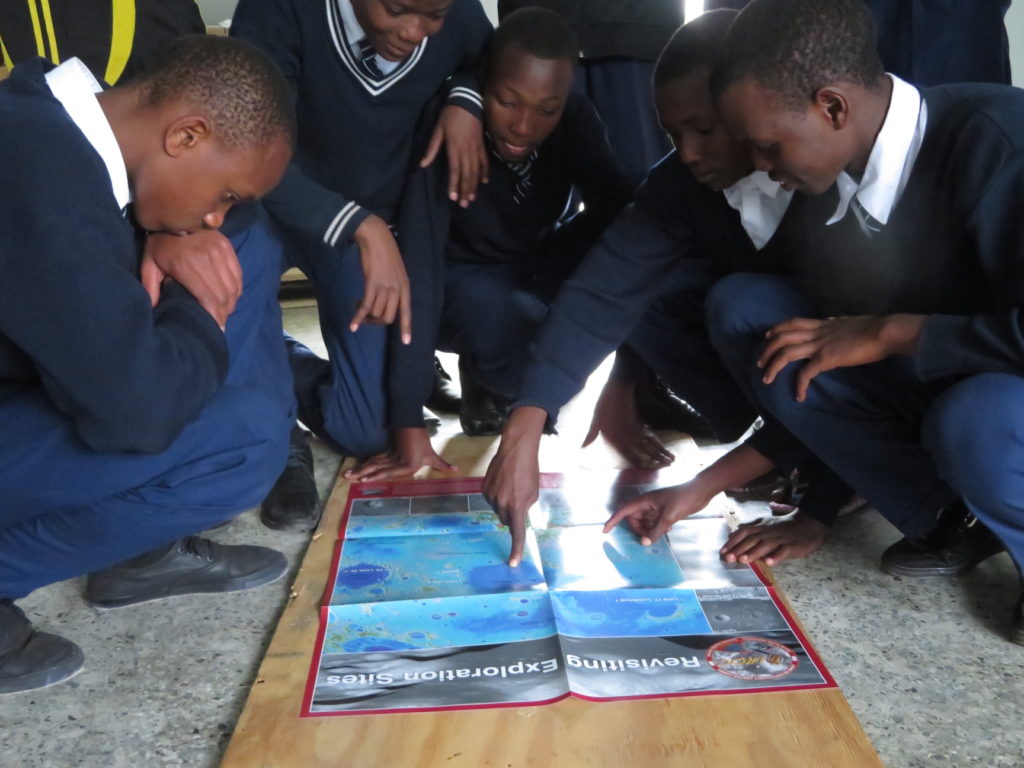
Today we opened the first of a number of posters (one of which is over 30 feet long, a print from ASU SESE of a crater on the Moon). Several Ailanga students who come by each day and help, ask questions, and engage were today looking at the map of the Moon. I explained how false color imaging is used to depict elevation, and asked them to determine, based upon their understanding of geology on Earth which areas were high and which were low.
Then, we continued our investigation of concave and convex lenses and how they affect light. I gave the students the Orion spotting scope to take outside, to focus sunlight and find the distance from the front lens to the focus. Of course, boys will be boys, no matter what country, and these photos show what they captured with my camera.
We also watched the first half of a documentary narrated by Neil deGrasse Tyson about the history of astronomy and telescopes. Once the observatory is fully operational, we will have a dedicated learning station with hundreds of science films.
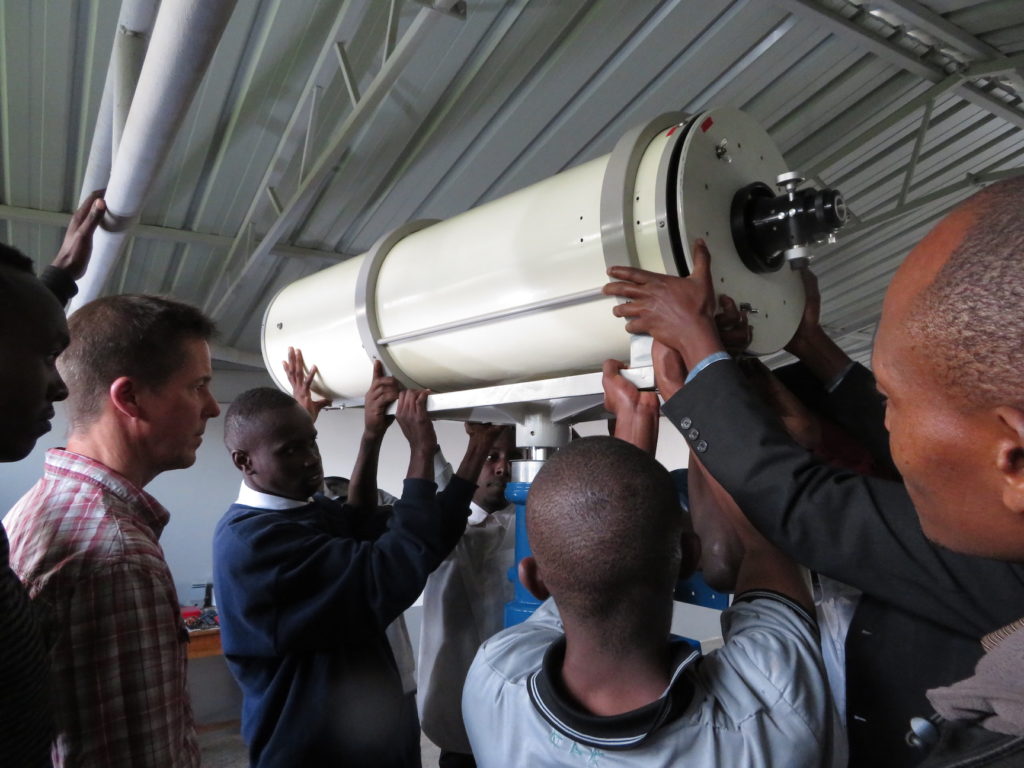
Today saw the installation of the new Orion spotting scope, declination collar and counter weight, and finally, after 12 days, what we hope is the final placement of the tube assembly onto the mount.
The spotting scope gave us some trouble as I had purchased it after the telescope had shipped, so none of the existing mounting holes fit. We had only a hand drill with very sloppy settings, so there was no way that would work. Eliona jumped on his motor cycle and drove to four local repair shops while calling friends and neighbors. He returned in 30 minutes with a “fundi” (worker) with a nice electric drill.
Using the drill bit set and taps I had shipped from the States with the crates, I was able to drill into the solid aluminum ring without penetrating into the fiberglass tube and provide a solid mount for our new guide.
We then attached the dec arm counter weight, which may be the first time it has been in place in 10, 15, or more years. The final challenge was lifting this new, fully assembled and quite heavy arrangement into place. While Eliona and I did so, Pendaeli held the dec arm vertical in case the weights on the right ascension arm were not ample to keep the telescope vertical (which would be very bad).
Once in place, we released our hands one by one, waiting, ready to catch if gravity flipped the telescope on its head. But it remained upright, solid, and so easily moveable.
Tomorrow we balance the entire assembly so that no matter how we oriented the tube, it remains exactly as positioned by hand. Then we attach the motors, power supplies, and hand controller to the car battery.
If all goes well, we’ll be observing Saturday night!
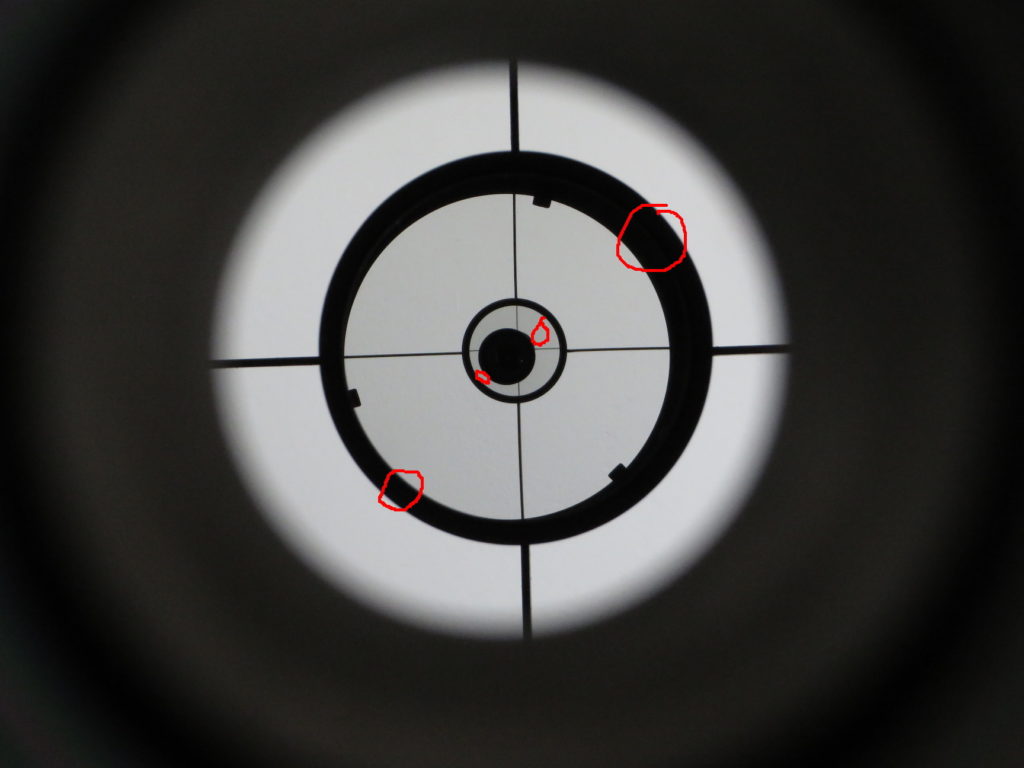
Two days ago we completed the collimation of the telescope. While we thought this was completed two days prior, closer inspection showed that the central image was egg shaped, an “oblique obstruction” as Dan Heim called it. Turns out that the image projected on the wall when a headlamp was strapped to the eye piece mount was different than the image we saw when receiving light in the same position.
This baffled us, as we assumed the reflective geometry was totally reversible. Then I noticed that I was tending to lean to the left side of the eye piece to get the secondary mirror to be centered. Because the eyepiece mount and projection tube are interconnected, literally sandwiched on either side of the primary mirror mount plate, this meant that the primary mirror was not perpendicular to the tube. Bad news!
We loosened all three bolts, removed one, and pulled on that setting. Sure enough, the secondary mirror moved directly into alignment. We were nearly ready to drill and tap a 24/20 hole as a temp restraint until a 1/2″ tap could be secured to remount the entire mirror, when it occurred to us that rotating the entire rear assembly 120 degrees might do the trick.
Sure enough, that was it! As this is a hand-built telescope, not manufactured, some of the items go together only one way. Even if they fit in others.
We had spent two afternoons trying to get the mirror aligned, but after that rear panel correction, it was done in 15 minutes. Amazing!
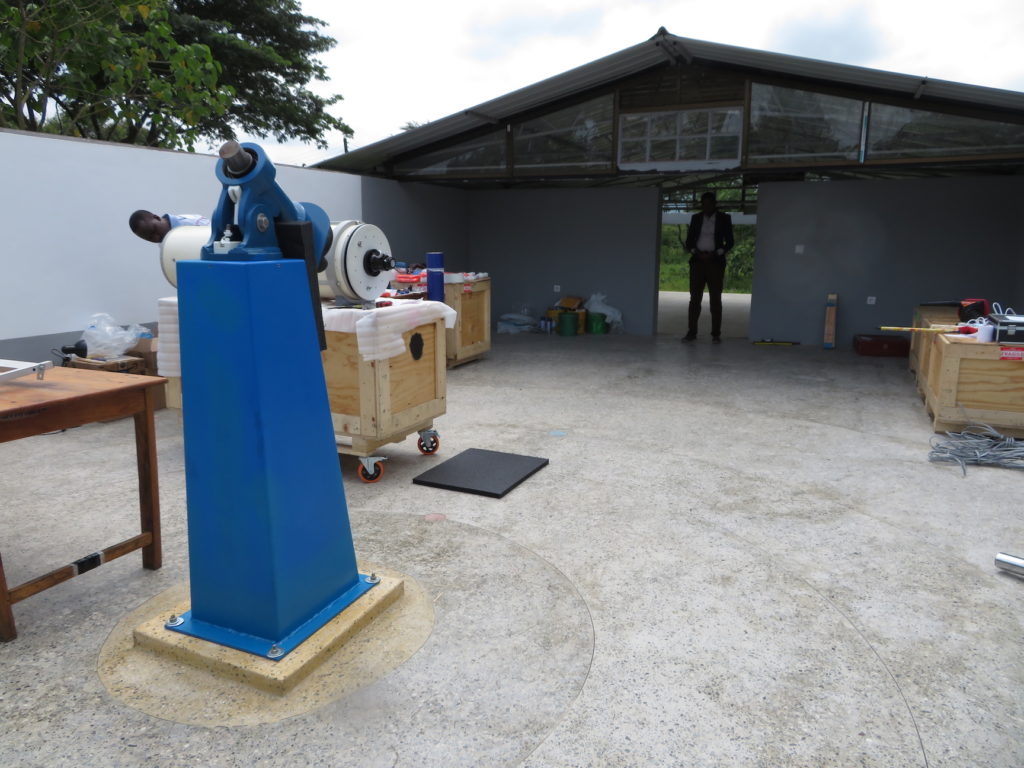
This is the Mt. Meru Astronomical Observatory with the massive roof rolled off. Truly, a very unique architecture.
The telescope is collimated! This was no easy endeavor, but finally, the mirrors are aligned. Photos and a deeper explanation to come. Also, today saw the second face-to-face meeting of the local Astronomy Ambassadors for the Mt. Meru Astronomical Observatory.
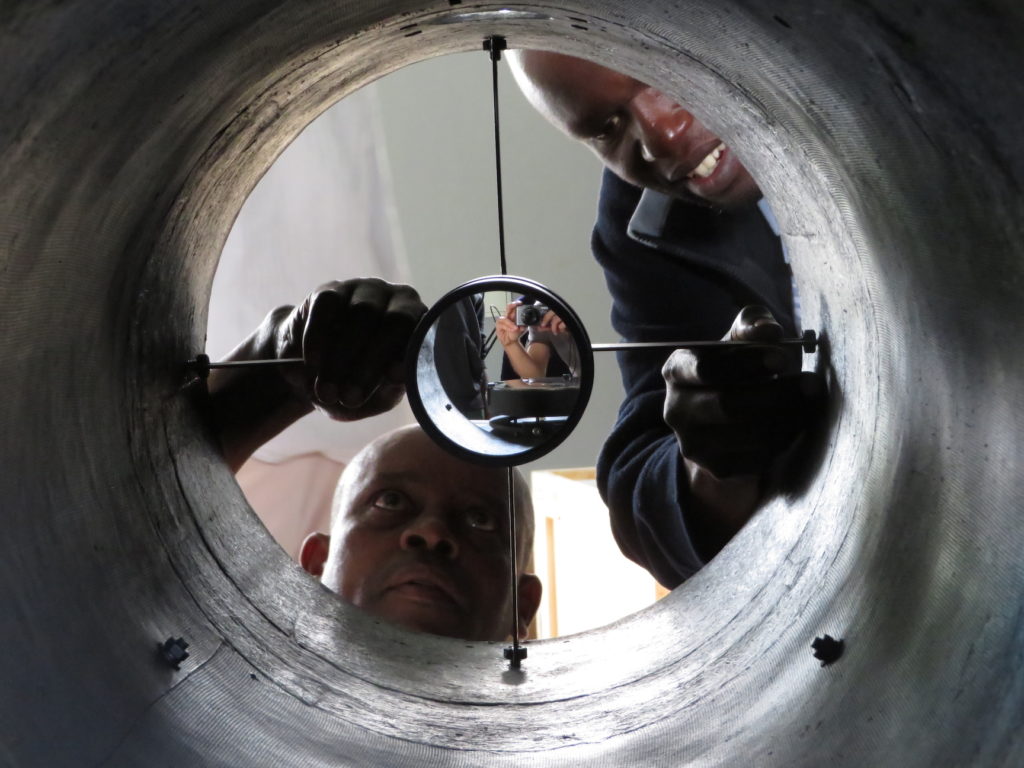
Today saw an incredible effort by instructors and students alike as we sanded and painted the pedestal, and then moved to install the primary and secondary mirrors. This is no small undertaking but was completed by a tenacious, dedicated group. Between major tasks we took time for exploration of various types of telescopes, discussion of nuclear fusion and the life of stars, and how various life forms both receive and generate light in the electromagnetic spectrum.
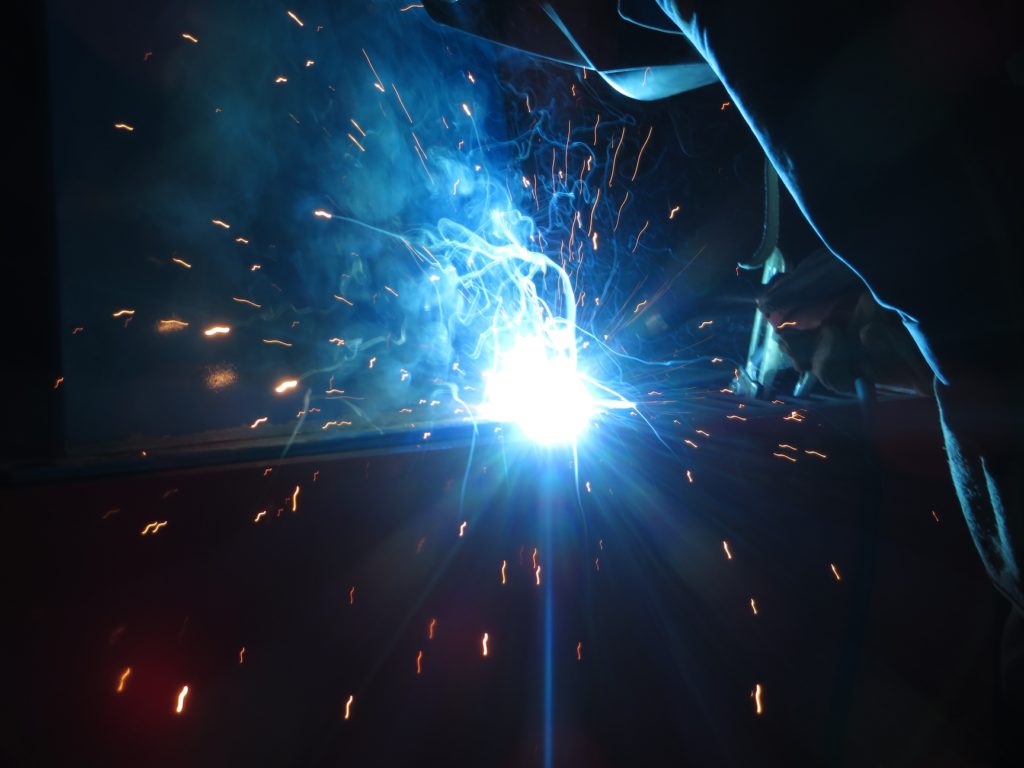
The past three days have seen a great deal of running to town to get parts and tools. Today we took the telescope’s original, 250lbs steel base to the Arusha Technical University in order to remove 30cm from the bottom, providing the necessary clearance for the telescope to clear the roll-off roof.
It was quite the adventure, complete with negotiations, Coca-Cola exchanges, navigating local streets and alleys on foot in search of a hand cutting wheel, and considerable, enjoyable time with the head professor and two students to make certain our collaborative effort gave us a square, level, modified pedestal.
In the end, it came out perfect! Tomorrow we sand, paint, and place the pedestal on the concrete pier, then assemble, balance, and align the telescope into next week.
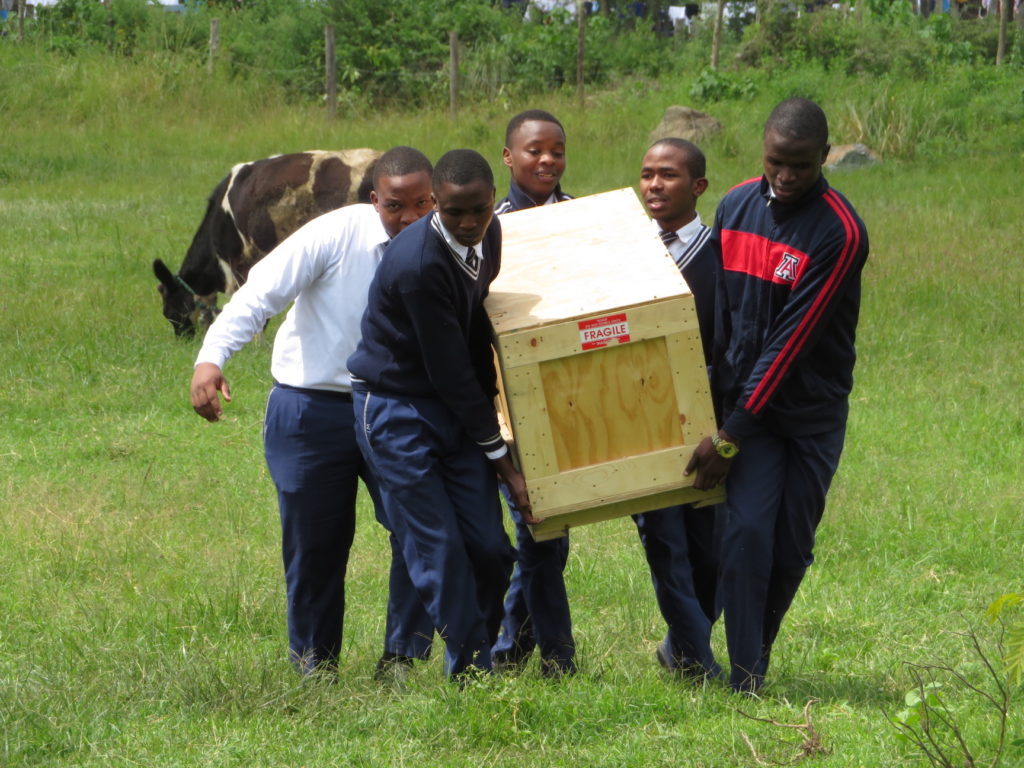
I arrived yesterday to Tanzania and the Mt. Meru Astronomical Observatory, operated by the Organization for Science Education and Observatory. I am immediately reminded of the beauty of this place, with roosters and song birds bringing the morning, elephants calling at the close of the day, and a body of dedicated teachers and eager students wanting to learn about the dark, East African night skies.
Today we moved the four crates that contain the telescope shipped in January to the observatory itself, opened and unpacked, and prepared a simple workflow for the days ahead. While waiting for the contractor to arrive to inspect the wiring, I gave an impromptu whiteboard lecture on the differences between an altazimuth and equatorial telescope mount; and two of the ways we can detect exoplanets.